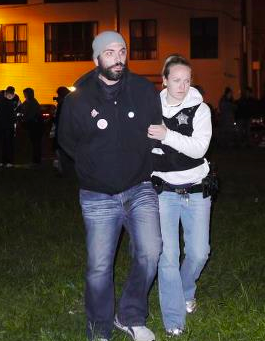Occupy Activists use ‘rapid response’ text messaging system to defend home from sheriff’s eviction [MN]
Occupy had boasted a presence at the home for 25 days, but only four or five activists were there guarding the front and back doors at 4044 Cedar Ave South when the sheriffs arrived at around 3:30 p.m. The activists quickly employed a rapid-response text messaging system that Occupy Homes had just put into effect, and within an hour, approximately 100 of their friends had arrived. Occupy activists cordoned off the street with signs and banners, the sheriffs deputies retreated, and Minneapolis police officials replaced them. By 5 p.m. the confrontation was diffused once it became clear that the city police would not seize the Cruz home.
http://tinyurl.com/c8h59el
Reflecting on Cleveland’s experience after passing the nation’s first responsible banking law two decades ago
Q: Is there any way you can gauge whether this law has reduced unsavory lending practices, prevented foreclosures or pushed banks’ support low-income communities in other ways?
A: We were hard hit by foreclosures. Our foreclosures were subprime loans and a lot of those were not purchase loans. But a high percentage of the subprime loans came in through the home repair door. So, they were targeting minorities, seniors and people for whom English was a second language. And they were targeting people with high equity. The city introduced an ordinance in 2002 which caused a lot of predatory subprime lenders to not have a Cleveland address. As we looked at foreclosures and defaults, our depository banks had a fairly low inventory of REOs [Real Estate Owned properties] and foreclosures in their loan portfolios with the city, where they were working on development projects and development activity.
‘Among the rebels’ – Nine camps, dozens of interviews and two months among the dissidents of Occupy
[Boston] When I arrive, much of the community is gathered in front of a towering spot-lit brick wall to hold the evening’s general assembly. The facilitators, a young German-American named Anna and a middle-aged man named Greg, first spend ten minutes explaining the general assembly process.
A young man named John stands up. His army issue cap covers his eyes: “The safety group proposes that we remove a certain individual, Henry [from the camp].” Henry is an alcoholic who is at times violent. Despite interventions and counseling from members of the camp, Henry is extremely disruptive. As the group debates the proposal, the hypocrisy becomes apparent: How can an avowedly inclusive community defend forcible removal of a member, especially in a public space?
In the next hour-and-a-half, the conversation vacillates between booting Henry out and allowing him to stay-illuminating both the success and failure of the camps.
In hundreds of parks in towns and cities across North America and the world, Occupy camps vitalize debate by “occupying” what might otherwise be abstract conversations with real people and real problems, often leading to real solutions. At the same time, the energy needed to care for the homeless, addicts, and mentally ill-members of the community most affected by the nation’s wealth disparity-undermines the progress of the movement.
Continue reading “The OB Media Rundown for 5/25/12” »





